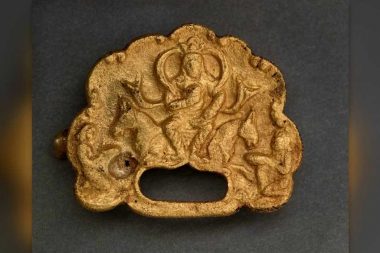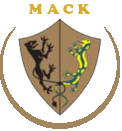 The ornaments contain the earliest known depiction of a Göktürk “khagan,” who probably lived in the sixth century.
The ornaments contain the earliest known depiction of a Göktürk “khagan,” who probably lived in the sixth century.
Some of the details on the best-preserved plaque have melted, but it shows a Göktürk khagan seated on a throne that represents two horses, flanked by kneeling servants. Archaeologists in Kazakhstan have discovered two gold ornaments in a 1,500-year-old tomb that feature the earliest known depictions of the great khan, or “khagan,” of the Göktürks-a nomadic confederation of Turkic-speaking peoples who occupied the region for around three centuries, according to an archaeologist who excavated the site.
The lavish gold plaques portray “the crowned sovereign, majestically sitting on a throne in a saintly pose and surrounded by servants,” Zainolla Samashev, an archaeologist at Kazakhstan’s Institute of Archaeology who led the excavation, told Live Science. “This clearly depicts the sacred nature of power in ancient Turkic society.”
The finds are from the Eleke Sazy site near Kazakhstan’s remote eastern borders with China, Mongolia and Russian Siberia, where Samashev and his colleagues have worked since 2016.
Archaeologists think the khagan depicted on both plaques was a member of the ruling Ashina clan, and may have been a relative of the Göktürk prince buried in the tomb. The sixth-century Göktürk tomb holds the remains of a nobleman, probably a “tegin”-or “prince” in the Old Turkic language-whose burial site had developed by the seventh century into a “cultic memorial complex” that deified the deceased man, Samashev said.
Samashev thinks the prince may have belonged to the royal Ashina clan of khagans-meaning “sovereign” in Old Turkic, and the origin of the word “khan.” The Ashina clan founded two Turkic states in the central Eurasian Steppes between the fifth and eighth centuries and ruled until they were conquered by another Turkic group who became the Uyghurs.
Golden plaques
The two gold plaques were found in the central chamber of the tomb where the prince was cremated; one was badly damaged by the fire of the cremation.Measuring about 1.5 inches (3.7 centimeters) across, both seem to be a form of belt buckle that would have had two ends of a belt threaded through a hole at its base so they hung down from the waist. Such buckles seem to have been a symbol of power in Turkic society, Samashev said, and may have signified that the wearer was a person of high status.
The khagan is shown in the center of each plaque, wearing an ornate crown and seated on a throne that depicts two horses; he is flanked by two kneeling servants offering food from a plate and a bowl.
These are the earliest verified depictions of a khagan of the Göktürk people, and probably of the great khagan himself, Samashev said.
It’s not known if the plaques were worn by the tegin who was buried there. They may have been worn by his aides, who deposited them during the cremation as a way of taking part in the sacred ceremony, he said.
Early Turks
The Göktürks or “Celestial Turks” of Central Asia may have originated as an ethnic group under the Xiongnu, who ruled the eastern Eurasian Steppe from about the second century B.C. until about the first century A.D.Many modern Turks are descendants of people who were part of the Western Turkic Khaganate, which formed after civil wars among the Göktürks in the late sixth century; and the Khazar Khaganate-the successor of the Western Turk Khaganate-which survived until the 10th century as an ally of the Byzantine Empire.
The tomb site probably developed as a social and cultural center for people to venerate the tegin and Göktürk beliefs, Serhan Çınar, an Ankara University archaeologist who also worked on the excavations, told the Turkish state-owned television channel TRT Haber. “The memorial complex at Eleke Sazy… [is] linked to the entry of the ancient Turks into the historical arena, along with their spiritual and ideological, religious and philosophical orientations,” he said.
Samashev said the complex was made from stone and earth and is about 300 feet (90 meters) long and 165 feet (50 m) wide, with two main parts each surrounded by a courtyard wall.
One part was the square-shaped main temple, which included the central burial chamber. A “labyrinth” for visiting pilgrims was built beside it. A central room of the labyrinth contained a stone sculpture-now broken and headless-which is thought to have represented the occupant of the tomb, Samashev said.
Hundreds of other artifacts have been found at the site. In addition to the gold plaques, archaeologists have unearthed objects of silver, iron and bronze; weapons; the remains of equipment for horses; and an amulet made from rock crystal, Samashev said.
